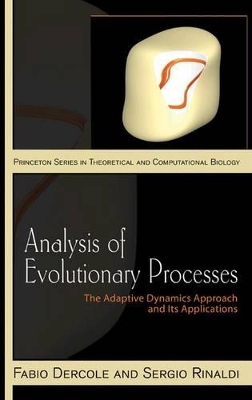
Analysis of Evolutionary Processes
Princeton University Press (Verlag)
978-0-691-12006-5 (ISBN)
Quantitative approaches to evolutionary biology traditionally consider evolutionary change in isolation from an important pressure in natural selection: the demography of coevolving populations. In Analysis of Evolutionary Processes, Fabio Dercole and Sergio Rinaldi have written the first comprehensive book on Adaptive Dynamics (AD), a quantitative modeling approach that explicitly links evolutionary changes to demographic ones. The book shows how the so-called AD canonical equation can answer questions of paramount interest in biology, engineering, and the social sciences, especially economics. After introducing the basics of evolutionary processes and classifying available modeling approaches, Dercole and Rinaldi give a detailed presentation of the derivation of the AD canonical equation, an ordinary differential equation that focuses on evolutionary processes driven by rare and small innovations. The authors then look at important features of evolutionary dynamics as viewed through the lens of AD.
They present their discovery of the first chaotic evolutionary attractor, which calls into question the common view that coevolution produces exquisitely harmonious adaptations between species. And, opening up potential new lines of research by providing the first application of AD to economics, they show how AD can explain the emergence of technological variety. Analysis of Evolutionary Processes will interest anyone looking for a self-contained treatment of AD for self-study or teaching, including graduate students and researchers in mathematical and theoretical biology, applied mathematics, and theoretical economics.
Fabio Dercole is assistant professor at Politecnico di Milano, in Milan, Italy. Sergio Rinaldi is professor of system theory at Politecnico di Milano and holds an appointment with the IIASA Evolution and Ecology Program. He is the coauthor of "Positive Linear Systems: Theory and Applications" and "Modeling and Control of River Quality", among other volumes.
Preface xi Chapter 1. Introduction to Evolutionary Processes 1 1.1 Origins of Evolutionary Theory 1 1.2 Genotypes and Phenotypes 5 1.3 Mutations 9 1.4 Selection 10 1.5 Evolution 13 1.6 The Red Queen Hypothesis 16 1.7 The Emergence of Diversity 17 1.8 Evolutionary Extinction 21 1.9 Examples 24 Chapter 2. Modeling Approaches 43 2.1 Overview 43 2.2 Population Genetics 47 2.3 Individual-based Evolutionary Models 53 2.4 Quantitative Genetics 55 2.5 Evolutionary Game Theory 59 2.6 Replicator Dynamics 62 2.7 Fitness Landscapes 64 2.8 Adaptive Dynamics 67 2.9 A Comparative Analysis 70 Chapter 3. The Canonical Equation of Adaptive Dynamics 74 3.1 The Evolving Community 74 3.2 The Resident-Mutant Model 76 3.3 The Example of Resource-Consumer Communities 79 3.4 Does Invasion Imply Substitution? 83 3.5 The AD Canonical Equation 88 3.6 Evolutionary State Portraits 95 3.7 Evolutionary Branching 99 3.8 The Role of Bifurcation Analysis 110 3.9 What Should We Expect from the AD Canonical Equation 116 Chapter 4. Evolutionary Branching and the Origin of Diversity 119 4.1 Introduction 119 4.2 A Market Model and Its AD Canonical Equation 121 4.3 A Simple Example of Technological Branching 129 4.4 Discussion and Conclusions 135 Chapter 5. Multiple Attractors and Cyclic Evolutionary Regimes 138 5.1 Introduction 138 5.2 A Model of Resource-Consumer Coevolution 139 5.3 The Catalog of Evolutionary Scenarios 144 5.4 Discussion and Conclusions 151 Chapter 6. Catastrophes of Evolutionary Regimes 153 6.1 Introduction 153 6.2 A Model for the Evolution of Cooperation 154 6.3 Catastrophic Disappearance of Evolutionary Attractors 159 6.4 Evolutionary Branching and the Origin of Cheaters 166 6.5 Discussion and Conclusions 169 Chapter 7. Branching-Extinction Evolutionary Cycles 172 7.1 Introduction 172 7.2 A Model of Cannibalistic Demographic Interactions 174 7.3 Coevolution of Dwarfs and Giants 177 7.4 The Branching-Extinction Evolutionary Cycle 182 7.5 Discussion and Conclusions 183 Chapter 8. Demographic Bistability and Evolutionary Reversals 186 8.1 Introduction 186 8.2 Biological Background 188 8.3 Asymmetric Competition and the Occurrence of Evolutionary Reversals 189 8.4 Slow-Fast Approximation of the AD Canonical Equation 195 8.5 Discussion and Conclusions 200 Chapter 9. Slow-Fast Populations Dynamics and Evolutionary Ridges 204 9.1 Introduction 204 9.2 Biological Background 207 9.3 The AD Canonical Equation for General Demographic Attractors 209 9.4 Evolutionary Sliding and Pseudo-equilibria 221 9.5 Results and Discussion 224 9.6 Concluding Remarks 229 Chapter 10. The First Example of Evolutionary Chaos 231 10.1 Introduction 231 10.2 A Tritrophic Food Chain Model and Its AD Canonical Equation 233 10.3 The Chaotic Evolutionary Attractor 235 10.4 Feigenbaum Cascade of Period-doubling Bifurcations 238 10.5 Discussion and Conclusions 241 Appendix A. Second-order Dynamical Systems and Their Bifurcations 243 A.1 Dynamical Systems and State Portraits 243 A.2 Structural Stability 248 A.3 Bifurcations as Collisions 250 A.4 Local Bifurcations 252 A.5 Global Bifurcations 259 A.6 Catastrophes, Hysteresis, and Cusp 261 A.7 Extinction Bifurcations 265 A.8 Numerical Methods and Software Packages 267 Appendix B. The Invasion Implies Substitution Theorem 272 Appendix C. The Probability of Escaping Accidental Extinction 277 Appendix D. The Branching Conditions 281 Bibliography 287 Index 325
| Erscheint lt. Verlag | 2.3.2008 |
|---|---|
| Reihe/Serie | Princeton Series in Theoretical and Computational Biology |
| Zusatzinfo | 6 halftones. 102 line illus. 10 tables. |
| Verlagsort | New Jersey |
| Sprache | englisch |
| Maße | 152 x 235 mm |
| Gewicht | 680 g |
| Themenwelt | Naturwissenschaften ► Biologie ► Evolution |
| ISBN-10 | 0-691-12006-4 / 0691120064 |
| ISBN-13 | 978-0-691-12006-5 / 9780691120065 |
| Zustand | Neuware |
| Informationen gemäß Produktsicherheitsverordnung (GPSR) | |
| Haben Sie eine Frage zum Produkt? |
aus dem Bereich


